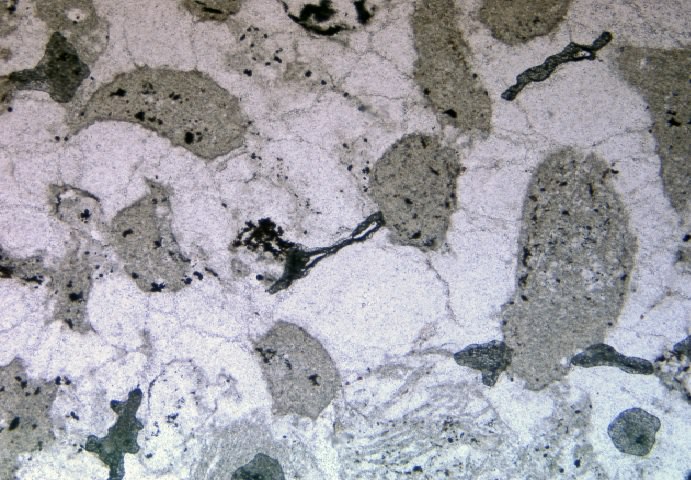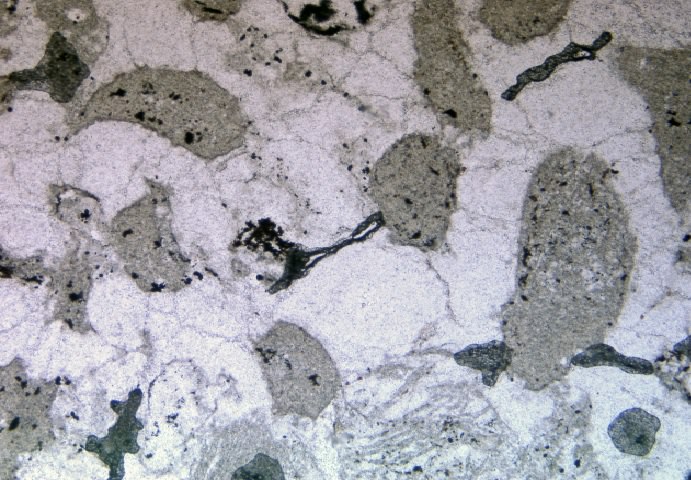Article from Barberton Times
The information is a follow up on the blog post of September 2013.
An image from a petrographic microscope shows the composition of the spherule bed. The image shows tightly compacted and therefore somewhat deformed round objects which condensed from rock vapour in the atmosphere and then rained out. Some spherules are glassy and therefore transparent, others are fine-grained and grey; they consist of clay- like minerals. Black spots are metallic minerals.
Research into the remnants of a meteorite impact, which was discovered in 2012 on Mountainlands Nature Reserve close to Barberton, is continuing.
Last winter, a second location was found, where the spherule bed could be traced.
Earth scientists are especially excited by the purity of the material at this site because the droplets or spherules formed by the impact rained into a deep ocean of the young Earth.
The melt droplets were deposited in quiet, deep water where they remained as a geological time capsule – undisturbed, well preserved and minimally contaminated by other material.
What remained of the meteorite impact today is a spherule bed that is about 30 cm thick that has been traced for about 25 metres in highly deformed rocks on a mountain ridge.
The thickness of the bed is nearly ten times that of the one that is associated with the demise of the dinosaurs around 65 million years ago. A few metres above and below the spherule bed, volcanic units have been discovered whose ages could be determined.
The underlying bed gave an age of about 3 273 million years, the overlying bed an age of about 3 246 million years. Currently, the experts believe that the impact spherules therefore represent the so-called S2 bed which derives from an impact that has been dated at about 3 267 million years old.
Geological mapping of the area places the impact remnant in context with its surroundings and allows geologists to draw cross sections through the mountains. This shows that the spherules fell into a deep water body which had hardly any currents at the bottom and was surrounded by distant shield volcanoes.
This past winter Prof Christoph Heubeck and his students from Jena University, Germany, visited the site again to trace the spherule bed yet further. This is part of an ongoing project to map the geology of the reserve in detail and to look for new geological points of interest.
Scanning electron microscope images clearly show the compositional material of the spherule bed which consists of various kinds of minerals such as silica and spinel.
The spherules used to be hollow or had a core and now have a ring of silica, indicating that it was quenched from a hot liquid. The material of which the spherules formed were more than 90 per cent impact rock; the remaining 10 per cent, which represents the impacting body, contains minute quantities of the isotope chromium 53, which is extraterrestrial.
“We also found high concentrations of iridium which is a heavy metal that is concentrated in the Earth’s core but more common in many meteorites. So both these geochemical indicators show that the material here has a bit of an extraterrestrial component. We now know of a second location, about 100 metres away from the discovery site, where we can trace the spherule bed for only a few metres and are waiting for analyses from other locations,” said Heubeck.
“So far scientists have found eight beds or remnants of impactors in the Barberton Greenstone Belt in a period spanning 200 million years and not all are found in the same rock sequence, but who knows how many there were where the residues were eliminated by currents or erosion or where they were just too small to produce any remnants?
We also see evidence of these impacts in the Pilbara region of Western Australia. The stratigraphy of the Barberton Greenstone Belt is similar to that of Pilbara and thus we may speak here of a global or super-regional event that took place,” he concluded.
http://barbertontimes.co.za/176475/zeroing-in-on-traces-of-meteorite-impact/


